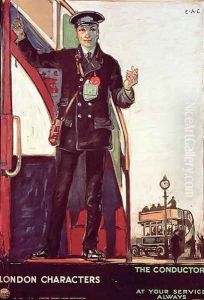Edward Morant Cox Paintings
Edward Morant Cox was a British artist whose work spans the late 19th and early 20th centuries, a period marked by significant transitions in the world of art, from the waning years of Victorianism into the modernist era. Born in 1880, Cox came of age in a time when the art world was experiencing tumultuous change, with the emergence of movements such as Impressionism, Post-Impressionism, and early expressions of Modernism. Despite these evolving artistic landscapes, detailed records of Cox's life and education remain scarce, reflective of many artists of his time who may not have reached the pinnacle of fame but nonetheless contributed significantly to the artistic tapestry of their era.
Cox's body of work, though not extensively documented, suggests he was influenced by the prevailing artistic movements of his time, yet he retained a distinct style that can be characterized by its adherence to realism and a keen observation of everyday life. His subjects often included landscapes, still lifes, and portraits, rendered with an attention to detail and a palpable sense of respect for the natural world and its inhabitants. This approach positioned him within a tradition of British art that valued technical skill and a deep connection to the subjects depicted.
Throughout his career, Edward Morant Cox was part of a broader community of artists working in Britain who navigated the challenges of an art world in transition, seeking to find their voice amid changing tastes and technological advancements, such as the rise of photography. His contributions, while perhaps not as widely recognized as those of his more famous contemporaries, underscore the depth and diversity of talent present in this era of British art.
Cox's passing in 1953 marked the end of a career that spanned over half a century, a period that witnessed two World Wars, the Great Depression, and significant shifts in artistic philosophies and methodologies. The legacy of Edward Morant Cox, like that of many artists of his caliber and time, is a testament to the enduring nature of art as a reflection of human experience, capable of capturing the essence of its era while simultaneously offering a window into the individual soul. His works, preserved in private collections and possibly in public institutions, continue to offer insight into the nuances of early 20th-century British art, serving as a bridge between the past and present in the ongoing narrative of artistic expression.
